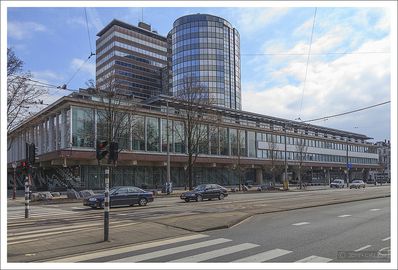

At this spot, now occupied by the modern building of the Dutch National Bank, a much more majestic building had once stood. Envisioned by one of the city's most interesting historic figures, Dr. Samuel Sarphati, The Industry Palace, occupied these grounds for 75 years untill 1929. Sarphati, inspired by his visit to the first ever world fair, the Great Exhibition of the Work of Industry of all Nations held in London in 1851, was convinced that Amsterdam and the Netherlands, which experienced something of a decline in the 18th and 19th centuries, must catch up with the leading industrial nations that had progressed at a more rapid pace at the time.
Sarphati established the Society for Industry, whose goal was to promote industry in the Netherlands and organize industrial exhibitions like those in London. A new palace of cast iron and glass, outwardly resembling the Joseph Paxton's Crystal Palace in London, was designed by Cornelis Oudshorn, who also drafted plans for another of Sarphati's great visions, the still surviving Amstel Hotel. During its 65-year existence, the The Industry Palace played a prominent role in Amsterdam's socio-cultural life. Its halls could accommodate up to 9000 people and it featured everything, from exhibitions to theater and opera performances to circus, film and even hot air balloon rides. Unfortunately, in 1929 the Palace burned down in a conflagration and the municipal officials chose not to rebuild this unique city landmark. More recently, numerous proposals by the Dutch intellectuals to rebuild the lost palace have so far gone unanswered.
The gallery of the Industry Palace survived the fire and was used extensively by small businesses and residents into the 1950s. There were plans to build an opera house and the new city hall on these grounds, although eventually this project was constructed at the Waterloo Square. The gallery was knocked down in the late 1950s and in 1961 the construction of the current building begun. The Dutch National Bank, theretofore located at the Oude Turfmarkt (the current location of the Allard Pierson Museum), moved into the new glass building in 1968.
King William 1st of the Netherlands founded The Dutch National Bank in 1814. With time, the DNB developed from a private lender into a state entity, and ultimately, with the introduction of the euro in 2001, became part of the European System of Central Banks and the Dutch prudential supervisor of the entire financial sector. The monetary centre of gravity then shifted from the DNB to the ECB in Frankfurt and the Dutch guilder was replaced by the euro.
Dutch gold reserve is hidden in the bank's vault which is located under the Singelgracht canal on the bank's south side. Much to the astonishment of the public, however, as it was recently revealed in the media, the bank's management admits that the bank keeps only 10% of the Dutch gold, the rest of which is spread around various reserves all over the world: in New York, Ottawa and London among other places.